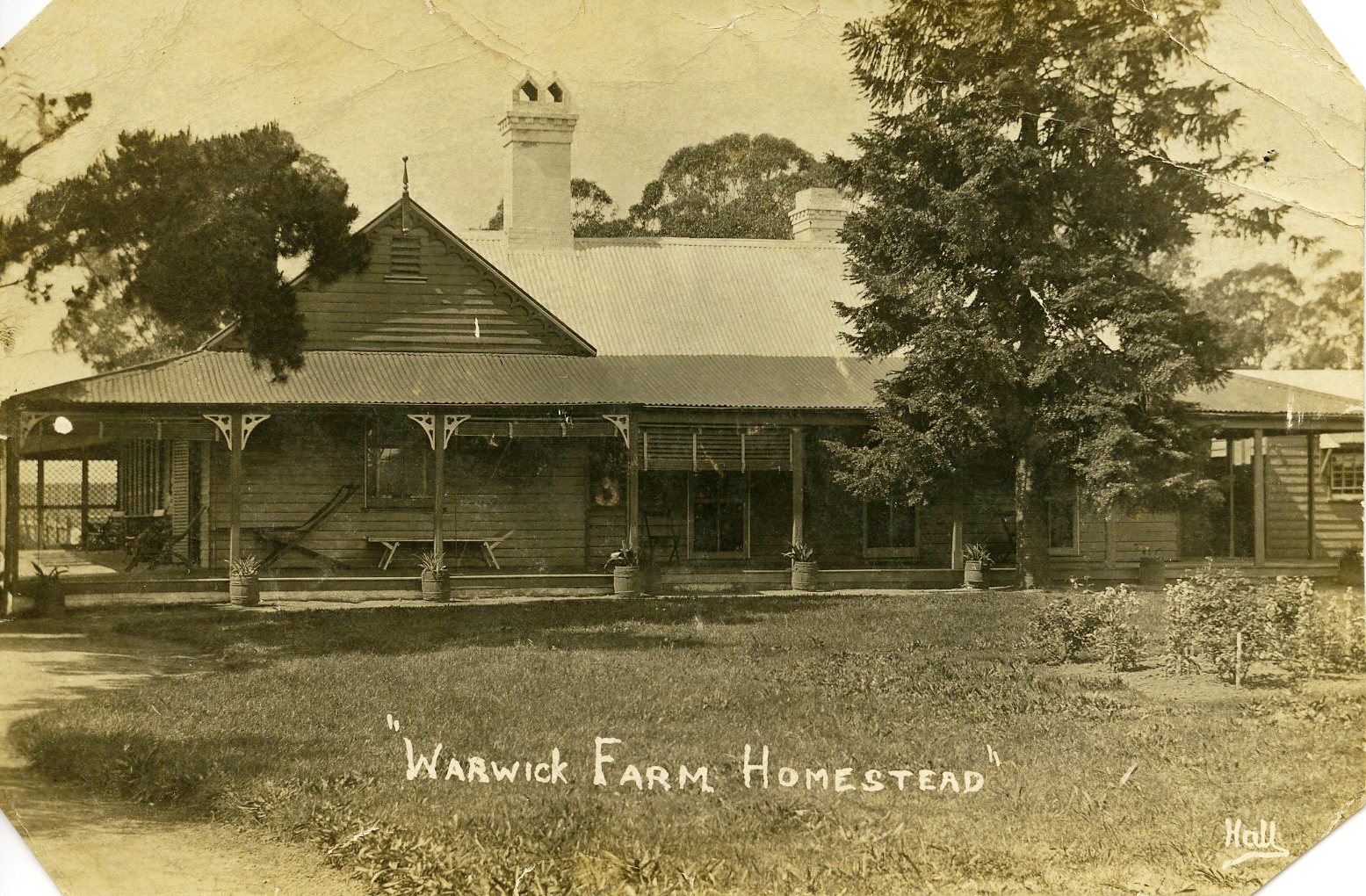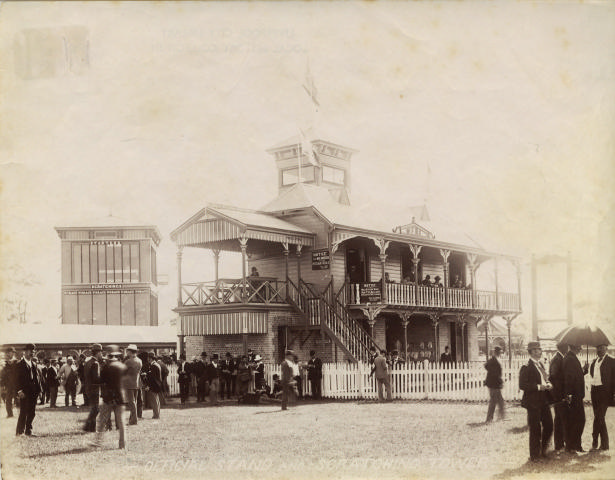Warwick Farm was officially gazetted on 7 April 1972.
The land was originally developed by J. H. Stroud before being sold to William Alexander Long in the early 1880s and then William Forrester in 1882, who changed the name from Warwick Park Estate (1804-1882) to Warwick Farm to match his initials (1882-present).
Colonial Land Grants
The suburb of Warwick Farm is named for Warwick Park, the estate owned by J.H. Stroud. Captain Phillip Gidley King granted 160 acres to Stroud in 1804. At the time Stroud was the Superintendent of the Female Orphan School. Stroud named his property Warwick Park after the town of Warwick in England. Stroud’s estate passed through several hands. Richard Sadleir, also a superintendent at the Orphan School owned it for a time, until it was purchased by William Long in in the early 1880s who had a passion for horse racing.

Warwick Farm Homestead was built in the 1880s and was located on the corner of Governor Macquarie Drive and Shore Street, Warwick Farm
Nearby were the properties of rebel Irishmen who had been exiled to New South Wales in 1806. One of them, Michael Dwyer, became Liverpool’s Pound-Keeper and Chief Constable. Dwyer was a leader of the Irish Rebellion in Wicklow, Ireland, after the main uprising in 1798 was suppressed. He held out in Wicklow Hills for five years, but eventually surrendered with other rebels in December 1803. He was transported to New South Wales in the ship Tellichevy in 1806, accompanied by his wife and two of their four children. In 1809 a grant of 100 acres was given to him on the south side of Cabramatta Creek. Dwyer left Liverpool in 1825.
Warwick Farm Racecourse
When Long sold the property in 1882 to William Forrester he renamed it Warwick Farm. He opened Warwick Farm Syndicate Race Club in 1889, where the first meeting was attended by Andrew Town, William Long and others prominent in the racing world, and supported by a crowd of over 5,000.
Forrester was an extremely successful horse trainer. Long’s horse Grand Flaneur won the Melbourne Cup in 1880. He trained the first-place horse Gaulus and second place horse in the 1897 Melbourne Cup and the winning horse The Grafter in the 1898 Melbourne Cup. The Grafter who placed second in 1897 and first in 1898 was jockeyed by Jack Gough, a Liverpool local. Forrester died almost destitute not long after his last winner, The Watch Dog, won the Ellesmere Stakes at Randwick Racecourse in 1901.

Official stand and scratching tower at Warwick Farm Racecourse, circa 1880
Early in the twentieth century the racecourse was owned by Edwin Oatley who died in 1920. His son, Cecil, was the Manager of the property for a few years, until 1924. Another son, Percy, was Secretary of the Warwick Farm Racing Club from 1906 until 1914.
After World War I, the army occupied the racecourse until after Forrester’s death. The camp was known as Camp Warwick and HMS Golden Hind. Later, the property was acquired by the Australian Jockey Club (AJC) in 1922. The AJC redeveloped the racecourse, adding new racetracks, a new railway platform and new buildings and stands, and re-opened it in April 1925. During the racecourse’s heyday in the 1920s, crowds of up to 25,000 would come to see champion racehorses compete. Some of the most successful horses were Beauford, The Hawk, Windbag and Manfred.
Soon after the outbreak of World War II the racecourse was occupied by the Australian and American forces until the end of the war. It was not until 1952 that horse racing recommenced on the site.
Warwick Farm Racecourse was closed between 1979-1982 for renovations.
In 2017 William Inglis and Son relocated its thoroughbred racing operation to Warwick Farm Racecourse.
Hargrave Park
In 1929 the Aero Club of NSW bought land at Warwick Farm for a Flying Country Club. The area was called Hargrave Air Park in 1930 but was also known as the Hargrave Park Aerodrome. A blueprint of the aerodrome situates it between the Hume Highway, Brickmaker’s Creek and Cabramatta Creek, which marked the northern boundary. The airstrip ran parallel with the highway between Old Sydney Road and the railway line. The Aero Club House was built on the north side of Brickmakers Creek. The club covered most of the land originally owned by Arthur Devlin and Hugh Byrne which you can see in early maps of Liverpool pre-1930s.
In 1944 the British Navy took over Hargrave Park as HMS Golden Hind. In mid-1946 during World War II Hargrave Park opened as an emergency housing settlement with 200 huts. This developed into Hargrave Housing Settlement and was closed in the early 1960s. Hargrave Park then became included in the suburb of Warwick Park.
Grey Water
Warwick Farm is a grey water irrigation success story, with irrigation water for the racetrack’s grassed areas being pumped from the Liverpool sewerage works.
Donald, Beverly & Casula Powerhouse Arts Centre (2007). Hargrave Park? : never heard of it : the story of a forgotten suburb. Casula Powerhouse Arts Centre, Liverpool, N.S.W
See something missing?
You know your suburb better than anyone. If you think an important part of your suburb’s history is missing, whether recent or distant, reach out to the Local Studies Team through our online Local and Family History enquiry form. We are always looking for new ways to bring the vibrant history of Liverpool to life!
